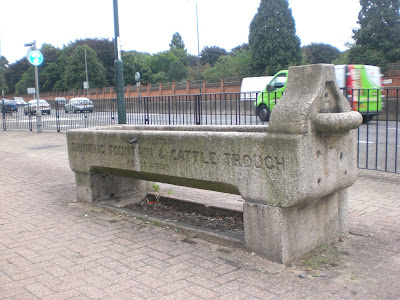Green & London, Chelsea, London SW (Fulham Road)
This one is a bit splattered with chewing gum but still shows its' local roots. Not a bad pattern - a bit reminiscent of a compass I think.
 Hayward's Non-Slip Patent (spotted in Charring Cross)
Hayward's Non-Slip Patent (spotted in Charring Cross)Instead of the usual metallic pattern incorporating lots of ridges and lines, Hayward's obviously thought that having a concrete in-fill was the way to go. They still kept the glass lights and the metallic, embossed name in the centre but it's a bit bland and I can't say it's one of my favourite designs.
 Addis's, Leicester Street, Leicester Square (Spotted near Regent Street)
Addis's, Leicester Street, Leicester Square (Spotted near Regent Street)Very strong and distinctive design where the typography is as prominent as the decoration. I don't know if the Star of David effect at the centre was purely decorative or whether it had some other significance - could it be that Addis was a Jewish-owned company? Anyway, it's certainly a strong and distinctive design.
 Hayward Brothers, London
Hayward Brothers, LondonLooks like an earlier effort to incorporate concrete into the manhole cover. Slightly more attractive than the one above and not without a hint of charm, but really not a coal-hole to boast about at cocktail parties ...
 J.W. Cunningham & Co., 196, Blackfriars Road S.E. - Iron Steel and Grindstone Merchants 1882 (spotted in Lower Marsh Street, Waterloo)
J.W. Cunningham & Co., 196, Blackfriars Road S.E. - Iron Steel and Grindstone Merchants 1882 (spotted in Lower Marsh Street, Waterloo)Well spotting this one is like having a penny Black in the collection, or some rare First Edition.
How much better can a coal hole cover get? Dogs, three-legged pots and all the information you can want about the makers. If that isn't enough you then find out it's 'highly sought-after' by the Greater London Industrial Archaoelogical Society who have some interesting information about the origin of the sign . To quote from the site above
Lily Goddard in her book 'Coalhole Rubbings' (1979) adds this.
'In 1823 young Charles Dickens, walking home to Lant Street, Southwark, over Blackfriars Bridge and into Blackfriars Road, noticed the sign of the 'Dog's Head in a Pot over a corner shop in St Georges Terrace, 'the likeness of a golden dog licking a golden pot over a shop door,' he wrote to a friend. This wooden effigy, preserved in the Cumings Museum (sic) in Southwark, had been known to people in the Borough since 1783 as the sign of an ironmonger's establishment.'
 Haywards Limited Patent, Union Street, Borough, London - Self Locking (spotted on The Strand)
Haywards Limited Patent, Union Street, Borough, London - Self Locking (spotted on The Strand)Larger than average as it was for an establishment, not a private dwelling, this effort looks more like a man-hole cover with its pattern of radiating diamonds.
















